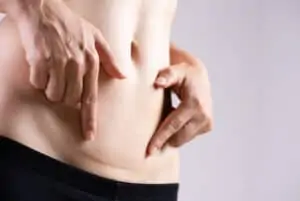I was lying in my hospital bed, still somewhat perplexed that this tiny little person was looking at me. As I was internally panicking and falling absolutely in love with my first child seconds later, I was soon about to be in a world of even greater hurt.
If you’ve yet to read about how I had my c-section in China, please go take a look.
And now we continue down my memory road stroll of life in the hospital postpartum with a c-section.
A group of nurses came into my room after I got to nurse my first baby for the first time (much thanks to my breastfeeding coach Vivien for helping with that). My baby was in a little bassinet next to the bed. The nurses spoke to each other in Chinese.
Then, they attacked me.
Ok, I’m only slightly exaggerating here. But it did feel like an attack. They were giving me a fundal massage after birth.
I think it needs a new name. That uterus massage after birth is anything but fun. I’d rather go to the dentist than deal with that again.
This uterine massage technique is supposed to be helpful. But I have to tell you that hurts. I almost forgot about it until one of my guy friends from high school finally had his first baby with his wife.
When he told me everything was fine until they massaged the fundus, I thought D’oh! Actually, I don’t think I forgot about it so much, as I blocked it out.
In any event, this post is all about the fundal massage after birth, plus what you should know about fundal massage complications and more.
What is fundal massage?
A fundal massage feels like torture though it is supposed to help. Basically, a nurse (or a team of them) will press down onto your abdomen and firmly massage your uterus. The focus is on the top of your uterus, called the fundus.
So, why the un-fun fundal massage?
Fundal massage for postpartum hemorrhage lowers your risk and helps your uterus shrink to its size before your baby occupies it.
When the nurse pushes and rubs that fundus, it causes contractions or afterpains (or pure hell, as I recall it).
My friends that delivered vaginally tell me that the fundal massage wasn’t as painful as giving birth. But they all collectively agree it sucked.
And yes, it sucked for me, too, because I just had a c-section. I mean, OUCH!
They came and massaged me for like a minute and then left the room, probably to torture some other new mom. I cannot for the life of me recall how often they came in, and my husband doesn’t even remember (MEN!), but they came back enough times that I begged my husband to get them away from me.
What does a fundal massage feel like?
It feels like pain; that’s what it feels like. I get that it’s named for the fundus; hence it’s called the fundal massage. But I feel like it should have some other name so you can brace yourself for the pain.

Or they should let you hit yourself in the face with a brick. I’m not sure which would feel better.
I will say it’s much like a painful contraction, like when you’re really in the thick of labor, and you feel like you’re splitting in two.
You know, because they are squeezing your uterus. And that area has just been through so much.
I’m not telling this to freak you out or make you terrified of birth. Birth is already terrifying no matter how much you read about it. I’m telling you this so you can talk to your doctor.
You may only need it right after birth. Or once every few hours. And there’s a lot more to it than that. Just brace yourselves, ok?
Why do they do uterus massage after C-section?
They give a uterine massage after a c-section to encourage the placenta to be expulsed completely. And they keep doing it immediately after birth and a little afterward to help ease back pain, headaches, fatigue, stress, and postpartum depression.
Basically, they want to reduce hemorrhages by providing this type of massage if your uterus isn’t already contracting on its own. The uterus, by design, however, should be doing this already. However, manual stimulation helps your body push out excess blood clots or backed-up birthing fluid.
In one study, fundal massages might not be as helpful as previously thought. They found that it was less effective than oxytocin to reduce blood loss. Using oxytocin meant there was no benefit left to gain from fundal massage.
Why does fundal massage cause uterine contraction?
You must also deliver your placenta after birth if you didn’t already know this. It’s called the third stage of labor. After this placenta is delivered, uterine massage can help your uterus contract.
Click here to learn about all 4 stages of labor.
By stimulating this top part of your uterus, the fundus, in a repetitive way, it helps the uterus contract and pushes out anything left behind to shrink back down to size.
Are fundal massages necessary?
Technically, a fundal massage should only be done when the uterus is soft. It doesn’t require additional massaging while contracting properly if it is firm and in place. In fact, it could worsen bleeding or disrupt the normal placental separation after birth.
So, again, something you should absolutely discuss with your doctor if you have questions about the fundal massage and whether or not you will need one.
If a miscarriage or abortion takes place, here is how this massage can benefit you.
How long do you massage the fundus after delivery?
Generally, the fundal massage is done for a minute at a time. It tends to be performed every 15 minutes in the first hour after you give birth. Then they make it every 30 minutes.
After each massage, the hospital team will check you to see if your bleeding has increased or if clots have come out. Be forewarned that they may put one hand in your vagina to keep it from inverting in severe cases.
The World Health Organization (WHO) says that postpartum hemorrhage causes nearly 1/5 of all maternal deaths worldwide, occurring in the first 24 hours after giving birth. This massage is thought to reduce to risk of this hemorrhage.
How often should you perform fundal massage after birth?
Some say the fundal massage can benefit 2 to 3 weeks after birth until the lochia becomes clear. But it can be harmful if too much pressure is applied. This is especially true if you’ve had a c-section. It’s not recommended for 6 weeks after you have a c-section, so speak to your doctor about what is suitable for you as you plan your delivery.
Remember that things can change instantly if you plan to have a vaginal delivery. I didn’t plan to have my first child via c-section, and look what happened. Always be prepared!
Leslie Berry lives with her husband and two young daughters in Los Altos, California, where she loves helping other moms get comfortable with motherhood and embracing the insanity with facts peppered with laughs.
She loves eating too much sushi, exercising, and jamming out on her Fender. Read more about Leslie here.






